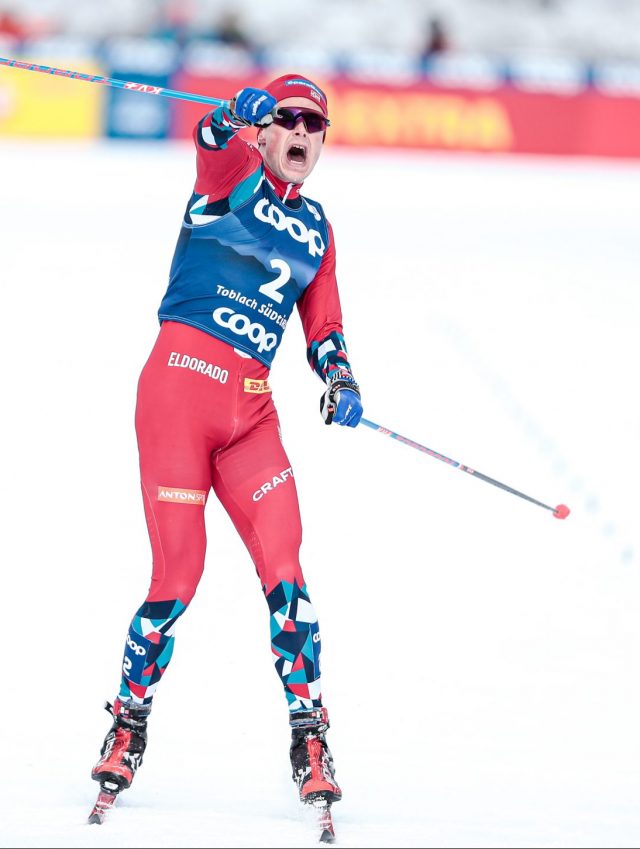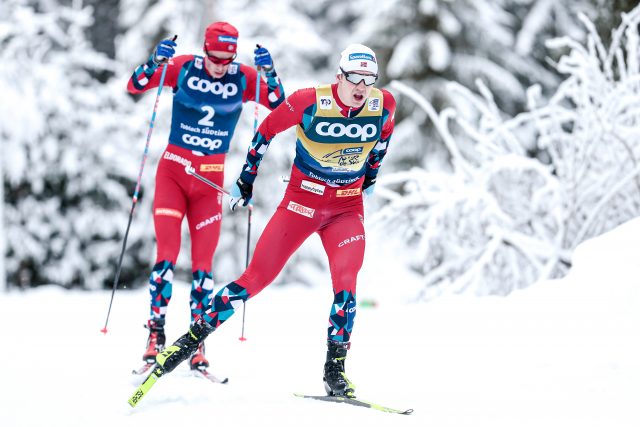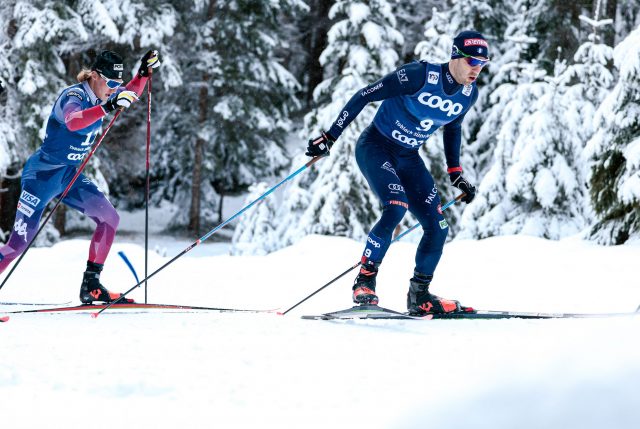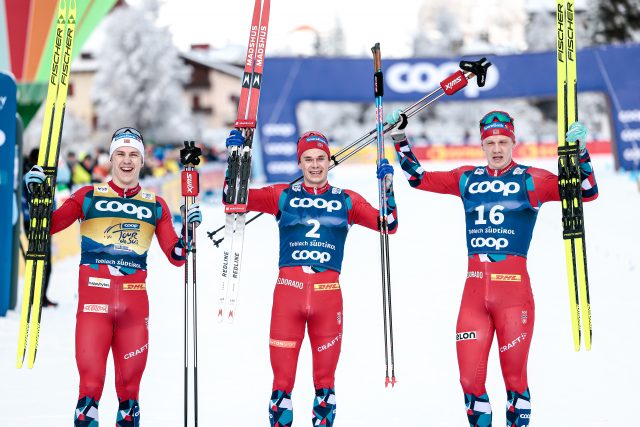 This coverage is made possible through the generous support of Marty and Kathy Hall and A Hall Mark of Excellence Award. To learn more about A Hall Mark of Excellence Award, or to learn how you can support FasterSkier’s coverage, please contact info@fasterskier.com.
This coverage is made possible through the generous support of Marty and Kathy Hall and A Hall Mark of Excellence Award. To learn more about A Hall Mark of Excellence Award, or to learn how you can support FasterSkier’s coverage, please contact info@fasterskier.com.

Pursuit racing is kind of weird—giving an additional head start to those already in the lead, while asking other racers to chase those who have already proven to be faster. It can seem like a bit of a set-up . . . one that Norway was entirely happy to benefit from on the third day of Tour de Ski racing from Toblach, Italy.
It must make Norway a bit nervous to endure a start like this one at the 2024 Tour de Ski: shut out of individual World Cup race podiums for the first time in recent memory. But, eventually, races get longer, the abilities of the distance skiers allow them to shake off the pluck and daring of over-reaching sprinters, and the status quo is re-established. After what appeared to be a few days of equitable, good-natured, highly entertaining, multi-national competitive ski-mayhem, Norway once again emerged at the front. The Tour de Ski returned to earth with a display of Norwegian dominance in the 20 k Freestyle Pursuit, and the state of affairs in the Men’s World Cup field returned to normal. Harald Oestberg Amundsen (NOR) entered the 2024 Tour de Ski as the prohibitive favorite for the overall title. On the first day of the new year, Amundsen lived up to those predictions with his commanding victory in the 20 k Freestyle Pursuit. He was followed across the finish line by a game Erik Valnes (NOR), and their countryman Jan Thomas Jenssen (NOR).
American, Gus Schumacher, raced courageously and intelligently throughout the day, remaining in the primary chase group to finish tenth, a performance that places him tenth in TDS Overall standings, as well. Other American finishers included Scott Patterson in 28th, Ben Ogden 33rd, Zanden McMullen 48th, Kevin Bolger 66th.
For Canada, Antoine Cyr continues a string of fine performances in 19th, followed by Olivier Leveille 58th, and Julien Locke 79th.

Men’s 20 k Freestyle Pursuit
Ski racing is not always what it seems. The 20 k Pursuit contested in Toblach was actually 22 kilometers in length—five laps of 4.4 kilometers each—on a course that many competitors consider “easier” than the typical World Cup distance course.
Tour leader at the beginning of the day, Valnes was first to start, followed only four seconds later by his countryman, Harald Oestberg Amundsen. Ben Ogden (USA) started third, 28 seconds behind the leader. Perttu Hyvarinen (FIN) started fourth, followed by Lauri Vuorinen (FIN). Those five represented the top of the overall standings at the beginning of the race. The end of the race would see numerous changes . . .
The two leaders started relatively close to one another; most of the other early-starting racers were separated from each other by gaps of 20 seconds or more. Chasers would have a difficult time grouping up unless early starters slowed intentionally. The top two Norwegians quickly paired up while Ogden was left alone to either chase, or sit up and wait for help to arrive from behind. By the end of the first kilometer, Hyvarinen had come forward: Ogden would have company.
Bonus Points were offered for the fastest skiers to cross the checkpoint at .7 k. Mika Vermuelen (SUI) captured the winner’s 15 points, ahead of Henrik Doennestad (NOR). The inclusion of mid-race Bonus Points is an action-inspiring strategy on the part of race organizers—much like mid-race “Primes” offered in bicycle racing. It’s the system organizers have devised to play on the relative greed of individual riders, coercing them to sprint in the middle of the race (sometimes a disastrous tactical decision) for money or points. The idea of including a Bonus Points sprint within Toblach’s TDS Pursuit was to encourage skiers to start out fast instead of sitting up to wait for later-starting skiers to form a racing group. Ogden didn’t fall for it: he and Hyvarinen maintained a steady, conservative pace—ignoring the chance to race for additional points—until they were finally enveloped by the main chase group at the five kilometer mark.
Schumacher had started in a closely-packed group of starters who quickly formed the day’s main chase group, one that would grow to include William Poromaa (SWE), Jens Burman (SWE), Martin Loewstroem Nyenget (NOR), Beda Klee (SUI), Jules Chappaz (FRA), Hugo Lapalus (FRA), Friedrich Moch (GER), and Federico Pellegrino (ITA). As Ogden and Hyvarinen gradually faded back to this group, the two leaders simply stormed away.
Moch seemed determined to press forward in pursuit of the leaders—and Nyenget and Lapalus came forward to add to the torrid pace—but most others in the chase group seemed content to race those around them. Rather than work as a cohesive group, the chase group began to unravel. The French sprinter, Chappaz was quickly gapped and left behind. Ogden suffered a similar fate not much later while Schumacher continued to vie for position within the eleven-man chase group.
After the second of five laps, Amundsen had firmly established himself as the pace-maker while Valnes began visibly to struggle. Near the race’s halfway point, there was a moment when it seemed that the second chase group could catch the first chase. But Nyenget forged to the head of the front group, and they gradually pulled away from the other chasers. It seemed that no one wanted Paal Golberg (NOR) (who was in the second chase group) to come back into contention. All this went on while Amundsen and Valnes continued to maintain a gap of more than a minute.
At 15 k, Amundsen used the main uphill to distance Valnes. Raising the tempo—and the pace—Amundsen skied clear, creating a gap that grew quickly to more than ten seconds. Amundsen was gone, leaving Valnes to consider damage control, though he still enjoyed a cushion of over a minute to the group of chasers.

Midway through the final lap, Moch returned to the business end of the chase, initiating a pace (supported by Lapalus and Poromaa) that spread out the group and forced Schumacher and Pellegrino to chase hard to remain in contact. They managed to remain in contact, allowing them to sprint for a top ten finish.
Amundsen powered across the finish line alone, some 32 seconds ahead of a game but exhausted Valnes. The other contending Norwegians stormed to the front of the chase group up the final hill—Nyenget followed by Jenssen. Jenssen would come forward to grab third (just over a minute behind the winner), followed closely by Poromaa and Nyenget. Schumacher would hold on for tenth, just behind Pellegrino. The bodies of exhausted skiers lay strewn about the finish area as the racers showed the extraordinary strain of pack racing at this level.
Norway one, two, and three on the podium—Norway one, two, and three in the overall standings. At a certain point in Cinderella’s fairytale, the spell wears off: her coach turns back into a pumpkin, leaving her stranded on the road side wearing shabby, soot-stained clothes, and minus one glass slipper. It was fun to have been a beautiful princess for a while, but it seems tremendously difficult to keep it up. Just ask Ogden, Hyvarinen, and Vuorinen. Five more races lie ahead in the 2024 the Tour de Ski, and Gus Schumacher may still be racing in search of an elusive glass slipper. We’ll wait to see how this fairytale plays out.
Tour de Ski Stage 3, 20 k Freestyle Pursuit RESULTS
In Time of day RESULTS it was Jenssen with the day’s fastest racing time, followed by Henrik Doennestad (NOR) , and Lapalus. Schumacher’s finishing time proved to be the sixth fastest of the day.

John Teaford
John Teaford—the Managing Editor of FasterSkier — has been the coach of Olympians, World Champions, and World Record Holders in six sports: Nordic skiing, speedskating, road cycling, track cycling, mountain biking, triathlon. In his long career as a writer/filmmaker, he spent many seasons as Director of Warren Miller’s annual feature film, and Producer of adventure documentary films for Discovery, ESPN, Disney, National Geographic, and NBC Sports.



